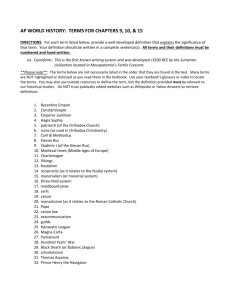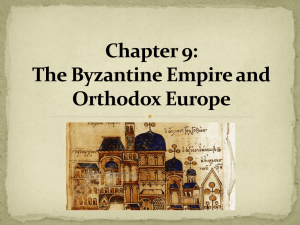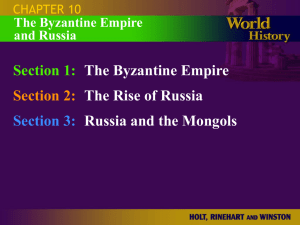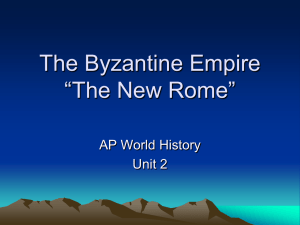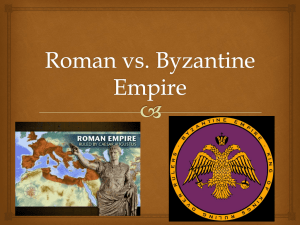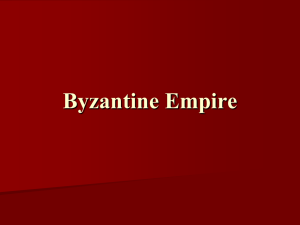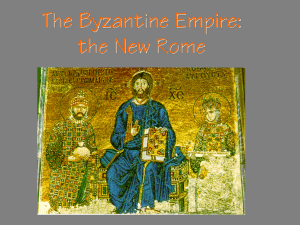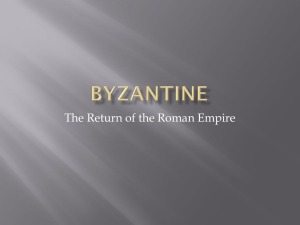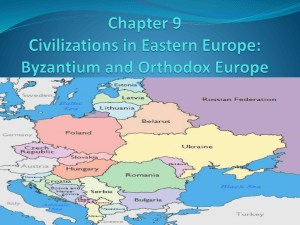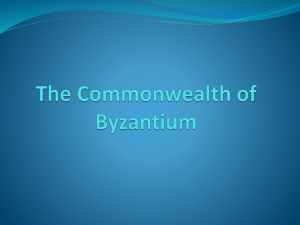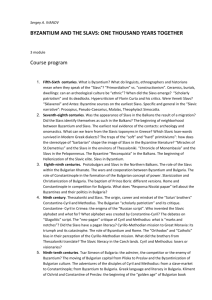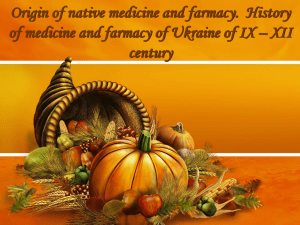Ch.9_byzantium_and_orthodox_europe
advertisement
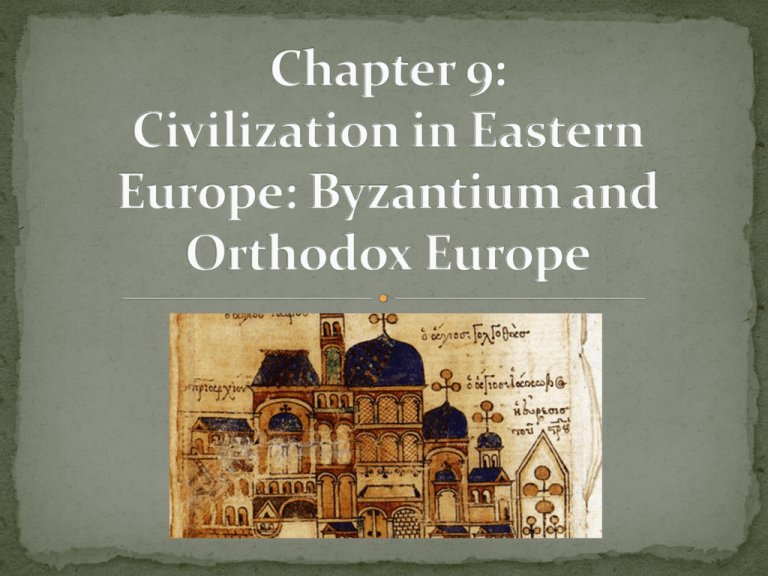
Ms. Sheets AP World History Political and Religious Division • Two Christian civilizations develop out of the split of Roman Empire. • East (Greek Orthodox) • West (Roman Catholic) • Each participated in major trade routes. • Civilizations expand and spread north largely because of religious missionaries. • Religions are culturally, and later even organizationally, separate Summary of Byzantine Empire • High levels of political, economic, and cultural activity during much of 5001450 • Rulers saw themselves as Roman emperors; government was seen as continuation of Roman Empire • Constantinople = capital (cosmopolitan, opulent, wealthy) • Greek/Eastern Orthodox Christianity • Retain strength despite rapid growth of Islam • Spread culture (religion) and politics to parts of world that had not been controlled by any major civilization • Balkans, western Russia Origins • Emperor Constantine of Roman Empire built Byzantium/ Constantinople in 4th c. • End of 4th CE: Roman Empire officially divided into East/West with capitals at Rome and Constantinople • Political style in East: complex administration centered around emperor with elaborate ceremonies • Involved in Mediterranean and Central Asian commerce Justinian (Reigns 527-565) • Most significant Byzantine ruler • Military gains and huge expansion to rebuild original Roman Empire • Gains in North Africa and Italy • Systemizes Roman legal code • Influences future law codes in Europe • Reduces legal confusion; united and organized the new empire • Projects to renovate Constantinople • Hagia Sophia – engineering and architectural achievements (dome) • Makes Greek official language • Political resistance from other groups Byzantine Height under Justinian Hagia Sophia Arab Pressure and Byzantine Defenses • After Justinian, Byzantine rulers’ primary concern is defense of empire against Arab invaders • Able to hold off Arab Muslims but with losses in Mediterranean • Arab naval fleet; battle over Mediterranean; “Greek fire” (think naval battle at King’s Landing in Game of Thrones) • Empire’s size/strength reduced • Economic burdens and loss of territory from Muslim wars • Increase in taxes; increase in wealth for upper class • Weak emperors Byzantine Politics • Emperors were the head of the government and the center of elaborate court rituals focusing upon their divinely inspired, all powerful nature. • Sophisticated and highly educated bureaucracy that was open to all classes (but aristocrats dominate). • Bureaucracy helped to organize empire politically, socially, and economically. • Provincial governors appointed • Control economy via regulation of food prices, trade (with Asia, Russia, Scandinavia, W Europe, Africa), and silk production. Monomachus Byzantine Culture • • • • Creativity in Architecture (domed buildings) Richly colored religious mosaics in a distinct Byzantine style Icon paintings (paintings of saints and religious figures) Cultural life blended Hellenism and Orthodox Christianity Monomachus, Christ, and Empress Zoe Split Between Eastern and Western Christianity • Separate paths emerge in 11th c. over disagreements • Attempted papal interference in Byzantine political and religious affairs • Debate over clerical celibacy (W – yes, E – no) • Dispute over bread to be used in Eucharist • Should state control religion (East)? Or should religion control state (West)? • West translates Greek Bible into Latin; East feels this isolates people from services • 1054: Patriarch Michael attacks Catholic practices • Mutual excommunication (patriarch and Pope Leo IX) • Church splits into two traditions: Greek/Eastern Orthodox and Roman Catholicism Byzantine Decline • Decline begins after 1054 (Church schism) • 1071: Seljuk Turks take most of Central Asian provinces at Battle of Manzikert (long-term strategic catastrophe for Byzantine) • Independent Slavic states emerge which diminish Byzantine power • 1095: Ask help from West to fight Turks, beginning of Crusades • 1204: Crusaders sack Constantinople; (thanks for the help!) • 1453: Constantinople taken by Ottoman Turks • 3 Groups contribute to destruction of Byzantines • Seljuk Turks (Battle of Manzikert) • Emerging independent Slavic states in Balkans (Bulgaria and Serbia) • Western crusaders The Byzantine Empire (1000-1100) Byzantine Empire went from a major to minor power after the Turkish defeat at Manzikert in 1071 Spread of Civilization in Eastern Europe • Eastern Europe is influenced by Byzantine conquest, Christian missionaries and conversion efforts, and trade routes • Byzantine Christian missionaries (Cyril and Methodius) helped bring Orthodoxy northward into Russia and the Balkans • Create new non-Latin alphabet: Cyrillic script The East Central Borderlands • Competition between Catholics and Orthodox Greeks for converts • Catholic converts are mostly in Hungary, Poland, Czech. • Influx of Jews to Borderlands from Western Europe and Middle East to escape persecution • Migrate into region in large numbers (Poland) • High value placed upon education and literacy for males • Often barred from agriculture; gain strength in local commerce The Emergence of Kievan Rus’ • Who are the Russians? • Groups from Asia moved into region during Roman Empire • Agricultural society of tribes, villages • Animist religion (sun, thunder, wind, fire) • Conduit for trade between Byzantines and Scandinavia • Luxury products from Silk Roads traded for furs from Scandinavia • 855: large trading city (Kiev) became site of monarchy under Prince Rurik, first Prince of Kievan Rus’ Politics and Religion in Kievan Rus’ • Vladimir I (980-1015) • What religion to choose? • 1000: Converts to Orthodoxy on behalf of all his people; organizes mass baptisms and forced conversions with military pressure. • Develops Russian Orthodox Church • Controls church and creates literate Russian priesthood • Yaroslav (1019-1054) • Develops and issues unifying law code • Arranged marriages with central European royalty • Translates religious literature from Greek to Slavic Conversion of Vladimir I Culture in Kievan Rus’ • Kievan Rus’ forms core of Russian culture and politics • Largest single state in Europe at this time • Russian culture borrowed much from Byzantium • Attracted to ceremony and luxury of Byzantium • Peaceful and trade-oriented relationship between Byzantium and Kievan Rus’ helps to facilitate cultural exchange • Greek Orthodox influence on Russian Orthodox Church • Ornate churches, filled with icons and incense • Monasticism develops, stress prayer and charity • Fervent religious devotion • Cultural production dominated by religion • Art (icons, illuminated manuscripts), literature (using Cyrillic) • Little interest in philosophy or science • Boyars, landlords/Russian nobility, less powerful than in West • Farmers are free Kievan Decline • Decline from 12th century • Kievan Rus’ was not the only kingdom in this region; other regional leaders and princes have large rival governments • Succession struggles within royal family • Central Asian invaders chip away at territory • Fall of Byzantium reduces Russian trade and wealth • Mongols (Tatars) invade in 13th century • Aided by rival princes, Mongols take major cities easily • Control much of Russia for over two centuries • Did not interfere with Russian religion, daily life as long as tribute paid • Two factors for Kievan Decline: • 1) Fall of Byzantine empire and 2) Mongol invasions • Orthodox Christianity and Russian culture remain Global Connections • Byzantine Empire • Participated actively in interregional trade • Constantinople: great trading city, connection between East and West • Maintained strong empire despite rapid surge of Islam, as well as developing cultural innovations and Orthodox Christianity • Kievan Rus’ • Dependent on Byzantium as main trading connection • Period of decline and isolation when Byzantium declines and Mongols invade • East cut off from western contacts, which stifles economic, political, and cultural sophistication. This will occur just as the West will begin to grow and strengthen.
